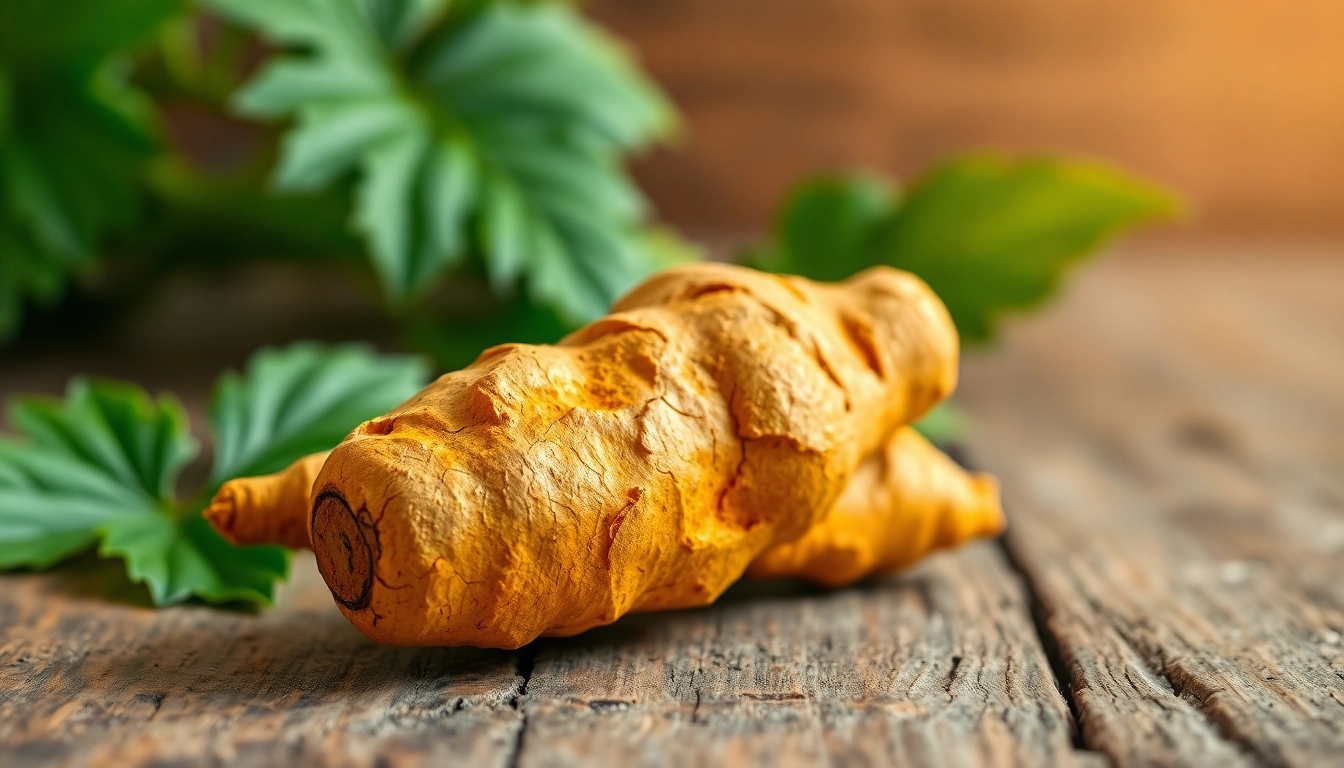Understanding Turmeric Root
The Botanical Background of Turmeric
Turmeric, known scientifically as Curcuma longa, is a flowering plant belonging to the ginger family, Zingiberaceae. The spice is derived from the rhizome (root) of this native Asian plant, which has been cultivated for centuries, especially in India and Southeast Asia. The vibrant yellow-orange color of turmeric not only adds a distinctive hue to various culinary creations but is also indicative of its active compound known as curcumin, which is primarily responsible for many of its health benefits.
Growth Conditions and Harvesting Process
Turmeric thrives in warm, humid conditions typically found in tropical and subtropical regions. Ideal growth conditions include well-drained, loamy soil and partial shade. The rhizomes are usually planted in the spring, and the plants take approximately 8 to 10 months to mature. Harvesting occurs in the late fall when the leaves turn yellow and die back. Farmers carefully dig up the rhizomes, wash them to remove dirt, and then either leave them whole, dry them, or process them into powder.
Exploring Varieties of Turmeric Root
There are several varieties of turmeric, each with distinct characteristics and culinary uses. The most commonly used variety is Curcuma longa, but there are other types like Curcuma amada (mango ginger) and Curcuma zedoaria (white turmeric) that are valued for their unique flavors and health effects. Additionally, turmeric can be found in different forms such as fresh, dried whole roots, and powdered, each serving different uses in cooking and herbal remedies.
Health Benefits of Turmeric Root
Anti-Inflammatory Properties
One of the most celebrated health benefits of turmeric root is its potent anti-inflammatory properties. Curcumin, the active ingredient, has been extensively researched and shown to modulate inflammatory pathways in the body. This can be particularly beneficial for individuals suffering from conditions such as arthritis, as it may help alleviate joint pain and stiffness. Studies have demonstrated that curcumin can inhibit the activity of numerous inflammatory molecules, providing a natural means to combat chronic inflammation.
Immune Support and Antioxidant Effects
The antioxidant capacity of turmeric root is another significant aspect of its health benefits. Antioxidants help neutralize free radicals—unstable molecules that can cause cellular damage and lead to various health issues, including chronic diseases and aging. By integrating turmeric into your diet, you can enhance your body’s defenses against oxidative stress, thereby supporting immune function and maintaining overall health.
Potential Role in Chronic Disease Prevention
Research has indicated that turmeric root may play a role in the prevention of chronic diseases, such as heart disease, diabetes, and certain types of cancer. The anti-inflammatory and antioxidant properties of curcumin help mitigate the risk factors associated with these diseases. A growing body of evidence suggests that regular consumption of turmeric can lower the incidence of these health conditions, making it a valuable addition to a balanced diet.
Ways to Incorporate Turmeric Root into Your Diet
Fresh vs. Dried Turmeric Root: Use Cases
Both fresh and dried turmeric root offer distinct flavors and benefits in culinary applications. Fresh turmeric root has a more vibrant flavor and can be used in smoothies, teas, or stir-fries. On the other hand, dried turmeric, commonly found in powdered form, is perfect for seasoning dishes like curries, soups, and marinades. When cooking with turmeric, combining it with black pepper can enhance the absorption of curcumin, maximizing its health benefits.
Recipes Featuring Turmeric Root
Integrating turmeric root into your meals can be easy and delicious. Here are a few recipe ideas:
- Turmeric Ginger Tea: Simmer sliced fresh turmeric and ginger in water for 10 minutes. Strain, sweeten with honey, and enjoy a warm cup.
- Golden Milk: Combine milk (or a non-dairy alternative) with turmeric, cinnamon, and honey. Heat until warm and drink before bedtime for a restful night.
- Turmeric Rice: Add ground turmeric to cooking water when preparing rice for a bright yellow color and subtle flavor.
Supplement Forms of Turmeric Root
For those who may not enjoy the taste of turmeric or wish to receive higher doses, turmeric supplements are available in capsules or tinctures. These forms are particularly beneficial for individuals seeking specific therapeutic effects, such as reducing inflammation or improving digestion. Always consult with a healthcare professional before starting any supplementation, especially if you are on medication or have underlying health conditions.
Addressing Common Concerns about Turmeric Root
Side Effects and Precautions
While turmeric root is generally considered safe for most people, excessive consumption can lead to gastrointestinal issues, including nausea or diarrhea. Additionally, individuals with gallstones or bile duct obstructions should use turmeric cautiously. Pregnant women and those taking blood thinners should also consult a healthcare provider before increasing turmeric intake.
Drug Interactions and Contraindications
Turmeric may interact with certain medications, such as anticoagulants (blood thinners), anti-inflammatory drugs, and diabetes medications. These interactions can potentially alter how these drugs work or increase the risk of side effects. It’s crucial to discuss with your healthcare provider if you plan to add turmeric root to your diet, especially if you are on medication or have pre-existing health concerns.
How Much Turmeric Root Is Safe to Consume?
The appropriate dosage of turmeric can depend on several factors, including age, health condition, and the form in which it is consumed. As a general guideline, a daily intake of 1-3 grams of dried turmeric or 100-300 mg of curcumin extract is often suggested for health benefits. For fresh turmeric root, incorporating a thumb-sized piece into your diet several times a week can be beneficial. However, always consult with a healthcare professional for personalized recommendations.
Where to Buy Quality Turmeric Root
Choosing Sustainable and Organic Sources
When purchasing turmeric root, quality is paramount. Opting for organic turmeric ensures that the product is free from harmful chemicals and pesticides—important for maintaining health benefits. Look for reputable brands that prioritize sustainability and ethical sourcing, ensuring fairness for farmers and workers involved in the cultivation and harvesting processes.
Online vs. Local Marketplaces
You can find turmeric root in local grocery stores, specialty health food stores, or online marketplaces. While local sources may provide the chance to inspect freshness and quality firsthand, online shopping offers convenience and sometimes a broader selection of products, including specialized forms like dried whole turmeric root offered at Turmeric Root.
Understanding Pricing and Quality Indicators
Pricing for turmeric can vary significantly based on origin, processing techniques, and quality. Organic or premium brands may command higher prices, but they often offer better flavor and health benefits. Quality indicators to note include color (a vibrant orange-yellow is ideal), texture (should be firm if fresh), and aroma (a pungent, earthy scent is desirable).



